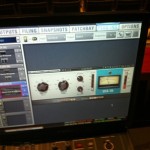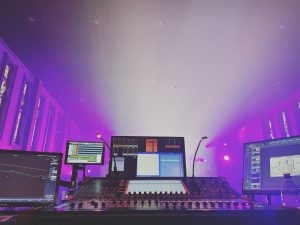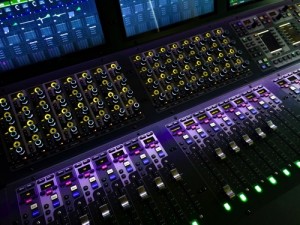
Dancing About Architecture: Part 2

Last time I talked about splitting elements in our mixes amongst three components: melody, rhythm, and bed. So let’s get practical on why this is important and what we can do with it.
In a lot of ways, the heart of mixing is building and maintaining balance relationships between these components. However, many engineers are led down a different path.
Whether you have good taste or not depends on how many people agree with you.
– George Martin
As mixers, we all have our own biases and tastes. For example, some guys favor guitars. Others favor vocals. Personally, I like the drums a little more forward in the mix at times, and I may even explain where that came from another time.
Our tastes are a part of who we are as mixers and will naturally influence our work. However, an easy trap many wind up in is letting their tastes override what the mix actually needs at any given time. Sometimes it’s just too easy to get hung up on specific instruments and where they sit in a mix, when we should really be thinking more in terms of function.
The thing I like about these three mix components–melody, rhythm, and bed–is they explain an instrument’s function and dictate a hierarchy amongst the elements of our mix that can supersede our personal tastes. These components then become powerful tools to help us prioritize the elements in our mixes especially when working with material we’re not as familiar with. These components won’t always explicitly dictate mix balances because style and the people who lead us will also have a hand in things, but these components can heavily inform the balance. So what specifically do these components mean to us in terms of mixing?
Melody elements are the most important elements of the mix. When in doubt, melody wins. If a listener can’t discern a melody, what’s the point of having that melody? While melody elements can be the loudest elements in a mix, what’s actually more important is clarity. Pushing melodies too loud might make them easier to discern, but this can also disconnect them from the overall mix. For example, improperly mixed vocals that are too loud are a good way to get that authentic karaoke bar mix.
Rhythm elements are the next most important elements. These are typically the foundation that holds the song together and drives it forward. Rhythm keeps the listener grounded and connected to the music especially if a melody goes to whacked out places. It gives the listener a map for where they are and where they’re going. Rhythm often holds a very prominent place in the balance of the mix within mainstream music, and in many hit songs you might notice that the drums can be the loudest thing in the mix. So, again, importance and priority doesn’t explicitly dictate balance relationships. A key thing to remember with rhythm instruments, though, is they require clear definition. The pulse and drive of rhythmic instruments typically comes from their attack, and when it’s hard to pick that out the rhythm often falls apart.
The Bed is typically a support element in the grand scheme of things which makes it a lower priority for the mix. Where the bed can be important, however, is in driving and expressing the emotion within a song. And emotion is an often ignored part of music by engineers. This is also why the bed doesn’t necessarily always sit deep in the background.
Now where this hierarchy can pay off is mixing time-management. If you’ve got an instrument that is only part of the bed, why spend all your time trying to get it right? Nobody cares how wonderful the droning organ sounds if the vocals are mush. Everyone has to figure out their own process for putting a mix together, but I like to mix based on priority so I get my melodic and rhythmic stuff sorted out first before adding in the bed. A general rule-of-thumb I often use is if an audience member wouldn’t play an air version of what an instrument’s playing, it’s low priority.
**** QuickTip ****
The quickest and easiest wins in mixing are to get the key melody and rhythm stuff right. There can be multiple elements in the mix comprising our three musical components that will need to get balanced accordingly within each component. However, in those situations there are typically still one or two things that drive the bus. If you can nail those two elements in your mix, they will often cover over any other inadequacies with the rest of the instrumentation.
**** End QuickTip ****
This hierarchy can also help in making decisions on how much space to give something within a mix. For example, if you’ve got a powerful singer that is generally the only melody element with a nothing-special band just playing the chord changes behind her, that singer can occupy a lot more space in the mix. On the other hand if you have a band that effortlessly plays complicated arrangements of melodies and counter-melodies with intricate rhythmic elements, space in the mix will need to be much more carefully distributed.
The last thing I’ll say right now about these components is that they can be moving targets and aren’t always cut and dry. Oftentimes, a single instrument may take part in multiple elements. For example, a bass guitar quite often will play a melodic bass-line that holds down the rhythm of the song. Other instruments may also move between these components. Maybe a guitarist kicks the song off playing the hook. In the verse he switches to a chunky, palm-muted rhythmic part which builds to wide-open chords during the chorus before bringing the hook back in the break. So he’s playing a melody in the intro, rhythm in the verse, and then maybe a combination of rhythm and bed during the chorus.
For me, this is where mixing gets fun, though. As instruments change their roles, the mix balances must also adapt. In some cases, musicians may make these dynamic adjustments on their own. However, in many cases it is up to the mixer to make these happen by actually MIXING. Sometimes this might mean making small adjustments and other times it might mean embellishing the dynamic changes of the band. Either way, the reality is that mixing is NOT about getting faders set to proper levels and then standing back. Mixing is an active and dynamic musical activity.
So bring out the melodies. Get the rhythm driving. And bring up the bed and emotion.

 Previous Post
Previous Post





